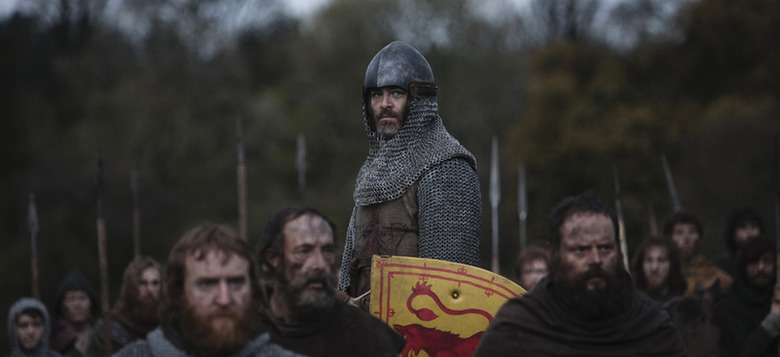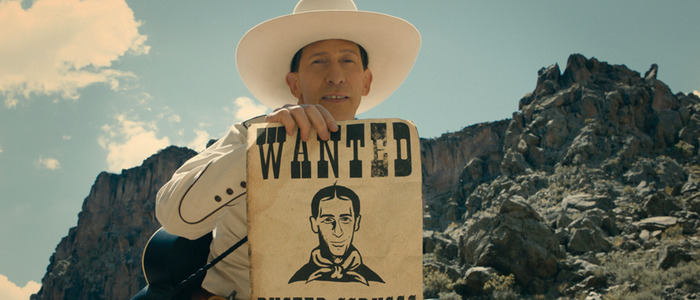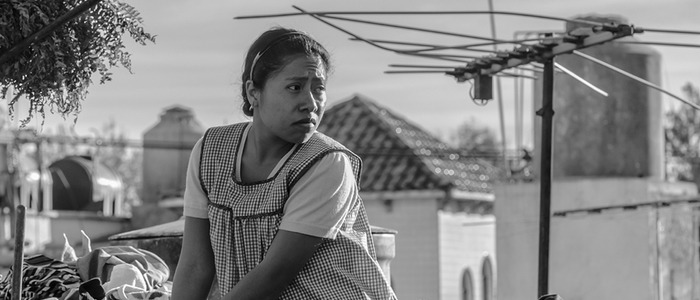Netflix's Three Biggest Fall Releases Belong On The Big Screen
I could not help but snicker, seated at a screening of the new Netflix film Outlaw King, as one of the studio logos appeared on screen. The studio name is Anonymous Content; in and of itself, it's not a funny name, but over the last few years, if there's anything truly consistent about Netflix Original Movies, it's that they feel like...well, anonymous content. It's hard for a week to go by without Netflix just dropping a new movie on its service, seemingly at random: here's a new romantic comedy! Here's a new David Wain film! How about a dystopian sci-fi pet project from Duncan Jones? And hey, we're going to just release the new Cloverfield movie on Super Bowl Sunday, too, just to keep you on your toes.
Netflix's choice to disrupt how movies are released and made is all well and good, but for a long time, their only pattern was randomly throwing tons of things at the wall (rather, the cloud) and hoping something stuck. But things may be changing. Somewhat.
Over the next couple months, Netflix is releasing a few genuinely high-profile films from major filmmakers. This month, they've got the aforementioned Outlaw King, from Hell or High Water director David Mackenzie, available now; and The Ballad of Buster Scruggs, the latest film from Joel and Ethan Coen, available this Friday. And in theaters, just after Thanksgiving (at least in markets like New York and Los Angeles), Netflix is unveiling Alfonso Cuarón's first film since Gravity, a black-and-white epic called Roma. Cuarón's Gravity lead Sandra Bullock is headlining another late-year Netflix film, Bird Box, too. (In the process of my writing this essay, they announced that they would release Andy Serkis' Mowgli in theaters a week before throwing it up on the online streaming service.) Buster Scruggs, Roma, and Bird Box, as officially confirmed recently, are all going to theaters first, before arriving on Netflix. That's right, Netflix has hit upon the novel idea of putting its movies in theaters before they're available for viewing at home.
You may feel like it's a rushed, haphazard choice for Netflix to wait until mere weeks before any of these films are released to confirm that they'll be released in actual movie theaters. That's because it is a rushed, haphazard choice. Over the last couple weeks, I've had the good fortune to see Outlaw King, The Ballad of Buster Scruggs, and Roma on the big screen, in spite of not living in a big market. (I'm located in the Phoenix metropolitan area.) Depending on where you live, you may not see any of these movies in theaters. Which is a shame because, quality aside, they all deserve to be seen that way first.
The Epic Scale and Truncated Story of Outlaw King
Of course, by the time you read this, and depending on where you live, you won't be able to see Outlaw King on the big screen; it's already wound up on Netflix. On one hand, this is the weakest of the three films, while also feeling like it should only ever have been seen in theaters. Meant to revive thoughts you might have of medieval epics like Braveheart, Outlaw King is set in the early 1300s in Scotland, focusing on Robert the Bruce as he attempts to get his fellow Scotsmen to fight against the tyrannical English. (One of the early victims of those nasty English, off-screen, is William Wallace himself.) While the story doesn't impress, Mackenzie has unquestionably made an epic film in size and scope. "We have a spectacle," the English King (Stephen Dillane) gleefully pronounces near the tail-end of the film's flashy, single-take opening shot that lasts about 10 minutes and features both a duel and an assault on a castle; no doubt, Outlaw King looks the part.
As in Hell or High Water, Mackenzie's leading man is Chris Pine, who acquits himself decently enough considering that he's working with a Scottish accent throughout. (With the obvious caveat that I'm not an expert of the Scottish tongue, Pine's accent is at least consistent from beginning to end. His American voice doesn't slip out at any point.) Pine's a bit more muted, much like the color palette Mackenzie's working with, and only in a few moments does the movie have any high emotion or intensity. Any intensity is mostly provided by Aaron Taylor-Johnson, as an exiled Scot who dedicates himself to Robert the Bruce, and seems quite delighted to get into the muck and brutally kill as many Englishmen as possible. (There's one shot when Taylor-Johnson is roaring with violent delight, drool hanging off his lips, that felt awfully, unintentionally laughable.)
But Outlaw King suffers from its grim setting — not that the setting could get any brighter or more visually appealing — and from feeling like there's very little to Robert the Bruce's story that's properly cinematic. A fair deal has been made of the fact that Mackenzie trimmed the film by 20 minutes after its premiere at the Toronto International Film Festival. (A fair deal has also been made about this film's full-frontal nudity courtesy of Pine, which takes up less screen time than the time it will take you to read this sentence.) Certainly, the version I saw was barely under two hours, but it did feel strangely truncated up to and including a climactic and famous battle that's as mired in muck as the rest of the film is.
The experience of watching Outlaw King is akin to watching the greatest-hits clip-show of a full-season TV series. To wit: Robert is first forced to be betrothed to a young Englishwoman (Florence Pugh), and by film's end, they're embracing happily and romantically, despite sharing very little screen time in between. Pugh's given a slightly more impassioned version of the "traditional wife who stays home while the man gets into fights" character to work with, but there's still a sense that Pine and Pugh could be a lot more charming to watch in a film with better material. The sense that this movie is rushed is amplified by one of the very strange ending title cards, telling us what became of Robert and his comrades, as it mentions a battle later in Robert's life and then a parenthetical reading "(But that's another story.)" So...great? Maybe tell that story instead? It's a tossed-off way to end a film that tries to communicate bigness on an epic scale, and will now be appreciated on your laptop. Or your phone.
A Hit-and-Miss New Coens Film
Where Outlaw King only feels like a truncated version of a TV show, The Ballad of Buster Scruggs initially began life as an anthology TV show. (At least, that's what Netflix said, but if you told me the Coens never really had any intention of making an anthology TV series, instead of a six-chapter film, I would believe you.) Presented as the six short stories of the book of the same name, Buster Scruggs is as emphatic and entertaining an encapsulation of the Coens' entire joint career as you'll find. Each story is punctuated by shocking violence — only in the final chapter is violence more discussed than depicted — and some of them feature characters whose major personality trait is their gleeful loquacity. One of the longer, quieter stories — "All Gold Canyon", starring Tom Waits — is slightly upbeat, at least relative to many of the other stories, which involve at least a few grim deaths or pitch-black punchlines.
The first story, sharing the overall film's name, sets the stage well, as Tim Blake Nelson plays a Roy Rogers-esque crooner on a horse, before revealing himself to be as vicious a killer as Anton Chigurh. The two big differences are that Buster Scruggs is an unassuming-looking fellow (Nelson's delightful in the role, playing up how non-scary he looks), and that he's exceedingly chatty, weaving the same kinds of verbal webs the Coens love to tangle inwards and outwards. Buster is as known for his murderous streak across the West, so it's not much of a surprise when his story comes to an abrupt end. A few of the other stories have similarly dark finales: "Near Algodones" has maybe the single best punchline in the Coens' careers, but it's awfully hard to beat "Meal Ticket" for its pitch-black ending.
By its very nature, The Ballad of Buster Scruggs is hit-or-miss; the good news is that the Coens' writing and direction, coupled with their capability at giving the West a grandeur not seen since the days when the genre was at its peak, is as sharp as ever. While some sections are stronger than others — the final chapter, "The Mortal Remains," is a step down from the other chapters and a more muted way to close the film — it's a fine example of why every Joel and Ethan Coen film is an event for many cinephiles. Event status is something Netflix is chasing when they hire directors like the Coens — it's not just the prestige of working with Oscar-winning filmmakers. It's working with people whose reputations as auteurs precede them.
That, in effect, is why I'm glad I saw Buster Scruggs in theaters. Watching it on my TV wouldn't be terrible, because I have a perfectly decent HDTV. But of course, you probably have a perfectly decent TV yourself. It doesn't really matter how nice your TV is because this film wasn't intended to be seen first on a small screen. This isn't equivalent to debating whether you should see, say, Dunkirk in 70mm or IMAX or 35mm or something else. Either way, you get to see it in theaters. Not many folks can get to see Buster Scruggs in theaters. You have to wonder how much filmmakers of a certain prestige level will want to work with a studio that presumes to skip the theatrical experience until the last possible second.
The Conundrum of Roma
Take Roma. Here's a film that, until a few weeks ago, was arriving on Netflix on December 14, with merely the hint or suggestion that a theatrical release was in the cards. Now, they're releasing Roma on November 23 in New York and Los Angeles, with other cities to come in early December, and then on Netflix on December 14. As mentioned above, I was fortunate enough to see Roma in theaters, and I do mean fortunate. Whatever else is true, let's be clear: if you have the chance to see Alfonso Cuarón's newest film in a theater, you need to take that chance. This is a remarkable visual and aural experience, if you're watching on a big screen with a great sound system.
I wish I could tell you that the characters and story of Roma were as remarkable as watching and hearing it, but alas. (Having seen the scores for this film on both Rotten Tomatoes and Metacritic, I can see that I'm in a very tiny minority. Such is life.) Set in 1970 and 1971 in Mexico City, the autobiographically inspired Roma depicts a slice of life for Cleo (Yalitza Aparicio), a live-in maid for a middle-class family. Cleo's own struggle occurs after she finds out she's pregnant from her martial-arts-obsessed boyfriend Fermin, who promptly abandons her; this happens against the backdrop of the family she works for dealing with their own troubles — father Antonio is a local doctor who leaves his wife Sofia and their four kids to gallivant with his mistress instead.
There's very little of import happening in Roma, but what I found most telling is based on what I read in the production notes. In the production notes, Cuarón talks about how he and his casting director looked for people who looked as close to his actual family members as possible, and went to the trouble of essentially recreating the house in which he lived as a boy. With Cuarón also serving as director of photography, and scene after scene with deliberate, slow-panning shots or static takes, there's a distinct sense of place within the house and the other places in Mexico the family and Cleo visit. This is an incredible undertaking of reconstructing a place that exists as much in the past as it does in Cuarón's memories.
But I struggled to engage with what was on screen. The performances — many of the actors, including Aparicio, are first-timers — are all quite good. Unlike some other films featuring relative newcomers, there's not a sense of awkwardness among the actors, especially Aparicio. And make no mistake, the way that Cuarón builds out a sensory experience, making full use of a theater's surround sound system, is remarkable. Often, the background sound is almost jarring, as you feel fully transported into this time and place in the past. But all the technical achievements can't hide the sense that the aggressively average story being told to service those achievements isn't able to measure up.
So in some ways, Roma is the greatest conundrum of all for Netflix. Though I appreciated it and admired it more than Outlaw King, and it's the exact opposite of the anonymous content Netflix has produced in the past, it's not as impressive as I might have hoped. But: you should see it in a theater. If you can. You may not be able to, of course; its technical prowess aside, this is more of an art piece than Cuarón's other films of recent years, and Netflix is treating it as such in its distribution pattern. (Earlier this week, it was revealed that the film is bypassing the Alamo Drafthouse chain entirely.) This is the great irony: Roma was clearly intended for theatrical presentation, but most people who see it will only do so on a TV or a laptop or a mobile device. What will Roma look like on your TV? Maybe if you have a 4K HDR TV with a kickass surround sound system, you might get a solid experience. But if you don't, what will you experience?
The difference of these experience can best be exemplified by something I noticed this past weekend. By now, as mentioned above, Outlaw King is on Netflix, available for you to stream. When watching that film, Buster Scruggs and Roma on the big screen, I took note of the fact that they all opened with a new Netflix logo. Not the white-background, red-text version. No, there's an entirely different (but not entirely remarkable) logo that culminates in a red-letter "N". Not "Netflix". I wondered: was that the same logo you can see when you stream the film on Netflix? Upon clicking play on Outlaw King, I learned that the answer is "no". Your experience is different from the moment you select the movie — you get the regular Netflix logo, not the theatrical one. Why create a new logo? Why not just use the same one? Or why not have the new logo in front of these films?
Maybe the best question is this: why does Netflix want to work with marquee filmmakers if it also wants to keep those filmmakers boxed in by your iPhone or MacBook? And why would those filmmakers want to work with Netflix? Next year, the studio is going even bigger with Martin Scorsese's The Irishman, a mob movie with an A-list cast to beat all other A-list casts. And it's from Martin Scorsese. Hard to imagine that you wouldn't want to see that movie on the biggest screen possible. Maybe by next November, Netflix will have figured things out more. Right now, they're only able to work with independent theater chains willing to accept screening a movie only a few weeks before it's on everyone's personal devices. But Netflix needs to figure things out, and fast. They say they want to disrupt the theatrical experience, but for now, it's obvious that the theatrical experience is disrupting Netflix.



